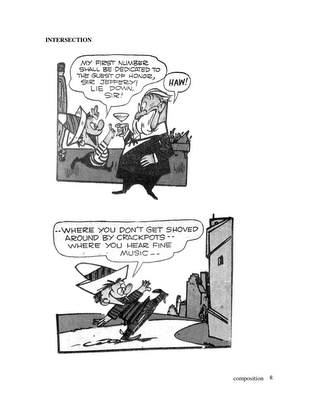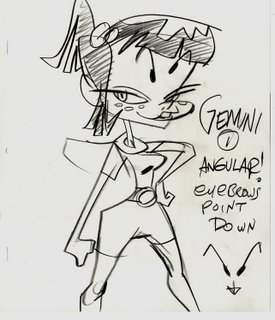all kinds of stuff
Friday, November 10, 2006
Thursday, November 09, 2006
Fox Pop (1942) - Bobe Cannon-Chuck Jones
In early Chuck Jones cartoons, Chuck gave his animators a lot of freedom to move things in their own styles. They had to use Chuck's key poses, but each animator had his own way of breaking them down and getting from one pose to the next.
This is an animator that I really like to watch-I'm not 100% who it is, but I'm assuming it's Bobe Cannon because it looks a lot like animation in earlier Clampett cartoons when Cannon worked for him.
If anyone knows for sure who this is, let me know!
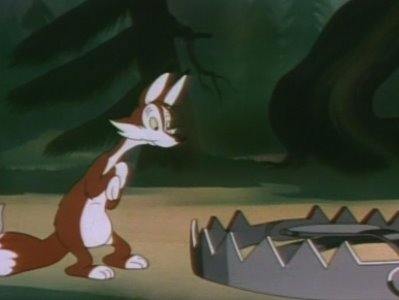

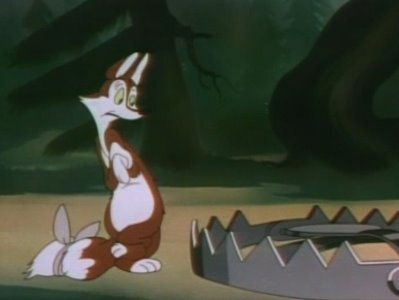
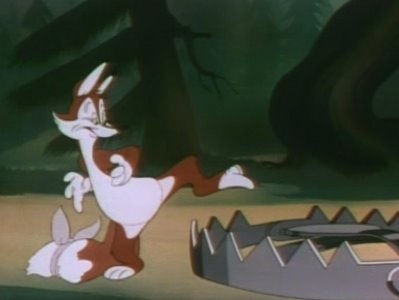
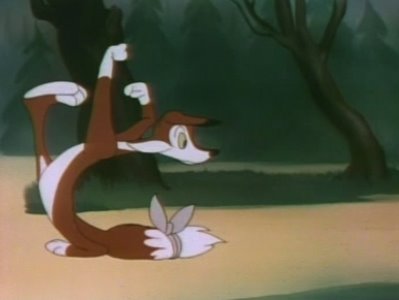



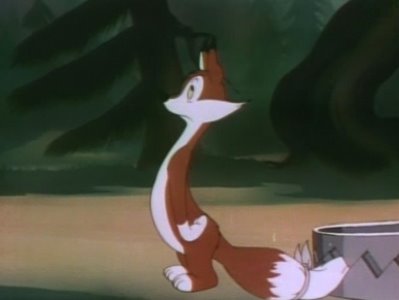
 Whoever it is draws great and moves everything in a very flowing way-almost like liquid wrapped in a tight elastic skin that can bend and stretch when moving fast.
Whoever it is draws great and moves everything in a very flowing way-almost like liquid wrapped in a tight elastic skin that can bend and stretch when moving fast.Nothing moves directly from one Chuck pose to the next-it moves in complex figure 8 type formations and waves, or it "smears".
It's not exactly what you would call funny movement, but it is beautiful and artistic and very distinct.
It makes Chuck's early films very entertaining to watch just from an animation point of view. When I first discovered this style, I was mesmerized-I guess I still am. It's a reason to animate, rather than just trying to imitate reality, or worse- to have no animation skill or fun at all, like today's cartoons.
Chuck's later cartoons were more restrictive in terms of movement, and for that matter, oddly enough, so were Bobe Cannon's.
Cannon's style (if this is him) gradually got stiffer, first in Tex Avery's cartoons at MGM, then in Cannon's own cartoons for UPA.
Fox Pop (1942) - Bobe Cannon
Uploaded by chuckchillout8
Clampett told me lots of stories about Cannon, how he got his name, how mild mannered he was, yet he was athletically built.
By the way, doesn't Chuck draw weird hands?? There's something perverted looking about this one, even though it is very well drawn.
Wednesday, November 08, 2006
Rip-a-Long CEREAL PRIZES



I've always considered myself a champion of the audience. While most of the industry conspires against being nice to humans, I fight to appeal to normal human desires. I don't succeed every single time, but at least I try.
When I do kids' cartoons I aim to give kids what everyone else refuses to. Like, can you imagine a super hero cartoon where the characters actually punch anybody? Well I had to fight executives for even the very few punches that appeared in a show about a genre that is all about punching.
In the Ripping Friends-a show that had many conspiring forces against it, I purposely crafted a segment to let the kids know that Spumco cartoonists were on their side.
I came up with a concept called "Rip Along With The Ripping Friends". In each of these sequences, kids would write the Ripping Friends to tell them who was being mean to them this week: Bullies, Teachers, Networks, Cartoon writers, Parents, Homework assignments, Lumpy toymakers, etc. The Ripping Friends would read the kids' complaints, empathize and then go after the monsters who dared to be mean to them.
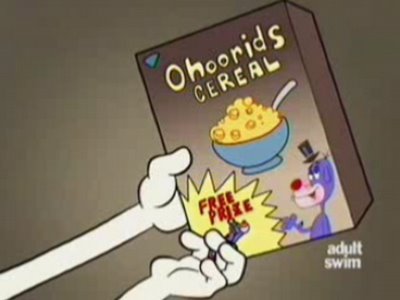 Cereal companies are mean now, but they used to love kids. They used to cover their cereal boxes with great cartoon art, games and cut-out-activities. They made great entertaining animated commercials, they sponsored cartoon shows on TV, they coated every single nugget of cereal with glorious sparkly sugar, but the thing they did best was...they put PRIZES in every cereal box!
Cereal companies are mean now, but they used to love kids. They used to cover their cereal boxes with great cartoon art, games and cut-out-activities. They made great entertaining animated commercials, they sponsored cartoon shows on TV, they coated every single nugget of cereal with glorious sparkly sugar, but the thing they did best was...they put PRIZES in every cereal box!In this particluar Rip-Along, The Ripping Friends try to find out who's responsible for not putting real prizes in cereal anymore and then they rectify the affront.
This segment pretty much illustrates my whole philosophy of entertainment-let actual entertainers do whatever they can to entertain their audience and stay out of their way, then collect the money. The irony of the animation here is that much of it is pretty blandly executed. I drew the first half of the segment and did my best to try to get everyone along the production line to trace my drawings exactly. They didn't, they felt compelled to add lumps to every drawing, but you can at least recognize my style underneath the lumps- in the first half of the cartoon.
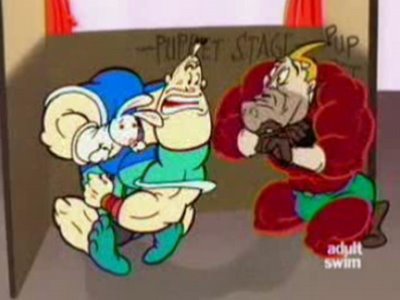



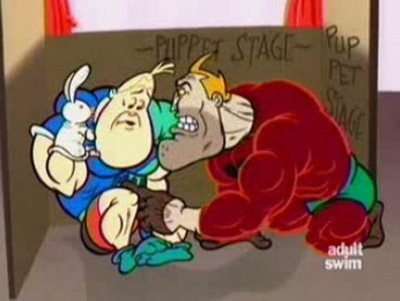
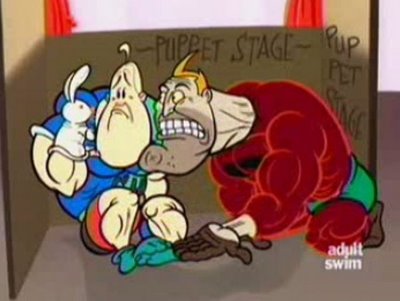
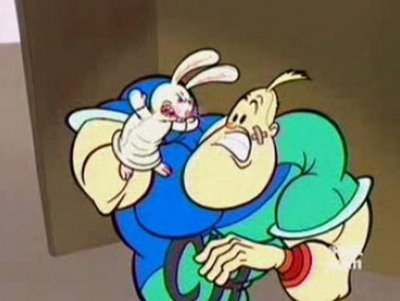
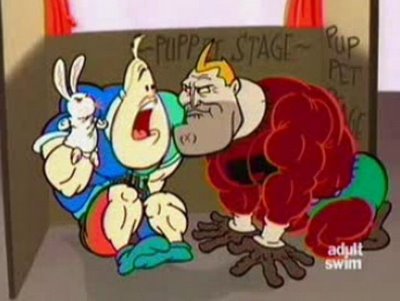
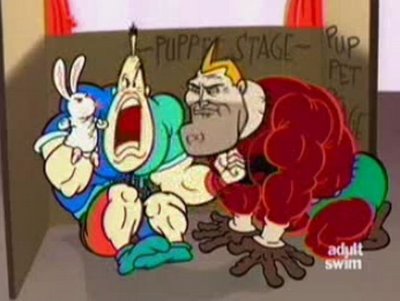
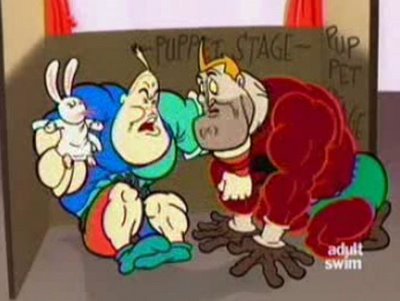



The second half of the cartoon is some combination of me and the generic Canadian style. It was storyboarded in a very funny style by Mike Kerr, but his board then went through the blandifying Canadian studio who composed eveything in the middle, designed ugly incidental characters and liberally piled the lumps all over the stuff. I did some of the drawings of Rip, trying to keep the life and wackiness that Mike did in the storyboard, but of course that had to be covered in lumps too.
It was this bland, symmetric uncomposed lumpiness that drove me to write up the manuals I have started to post on the blog.
 Even though the expressions in the drawing above are extreme by modern standards, notice that the features on either side of the face are totally symmetrical. The original drawings had a lot more life, but the Canadian director "fixed" them for me and evened them all out.
Even though the expressions in the drawing above are extreme by modern standards, notice that the features on either side of the face are totally symmetrical. The original drawings had a lot more life, but the Canadian director "fixed" them for me and evened them all out.After I caught him, he explained he had to do it, because Jim Smith and my drawings were "off-model". Jim and I designed the characters.
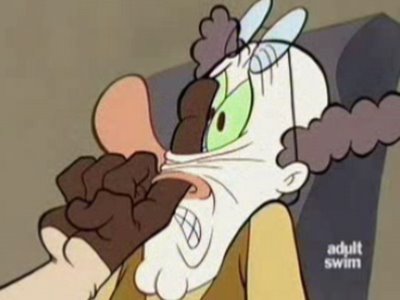
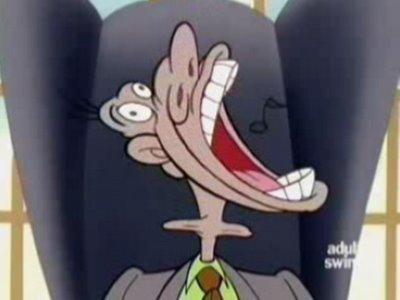 That same "director" designed this wonderfully appealing pile of lumps above.
That same "director" designed this wonderfully appealing pile of lumps above.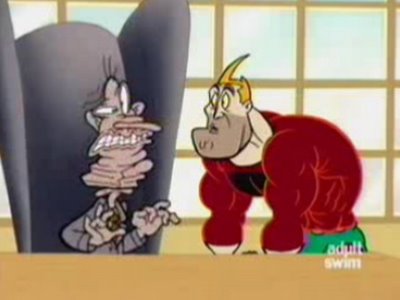
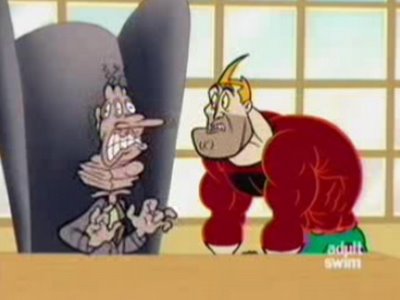 A lot of this art makes me cringe, but I'm going to show some clips now and then of stuff that I've screened at festivals that got a lot of laughs from the audience. Luckily for me, many modern cartoons have so dulled people's eyeballs that they can laugh at satire and gags despite many nasty drawings.
A lot of this art makes me cringe, but I'm going to show some clips now and then of stuff that I've screened at festivals that got a lot of laughs from the audience. Luckily for me, many modern cartoons have so dulled people's eyeballs that they can laugh at satire and gags despite many nasty drawings.
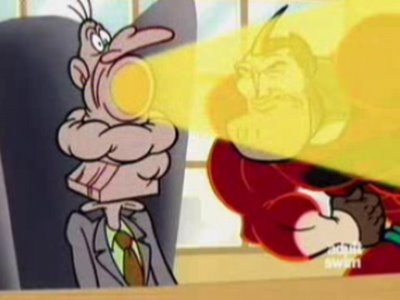

 See the pin-point eyeball pupils in the characters above? Dead. Robotic. Non-organic. I had to make manuals just to show Canadian studios how to make eyes look like they are coming out of living creatures. The manuals were hidden in the file cabinet of the idiot production manager. What was his name again, Mike?
See the pin-point eyeball pupils in the characters above? Dead. Robotic. Non-organic. I had to make manuals just to show Canadian studios how to make eyes look like they are coming out of living creatures. The manuals were hidden in the file cabinet of the idiot production manager. What was his name again, Mike? Wow! A slightly non-symmetrical drawing somehow slipped through the system! The director probably got fired for this.
Wow! A slightly non-symmetrical drawing somehow slipped through the system! The director probably got fired for this.Happy Birthday Kali!

Well it seems that this is a week of birthdays for cartoonist chicks.
Today is Kali's birthday so go wish her a happy one at her blog!
http://kalikazoo.blogspot.com/
 These are all caricatures of Kali, Katie and Marlo by who else-Katie!
These are all caricatures of Kali, Katie and Marlo by who else-Katie!
 I'm settin' up the party now, Kali!
I'm settin' up the party now, Kali!Tuesday, November 07, 2006
COMPOSITION For Layout and BG artists - part 1 - Framing

Mary Blair is not only great at color, she is great at composition. A lot of young (and old) artists who say they love Mary Blair's work think they like it because it is simple and stylized. They miss what's really important in her work-fantastic art principles-like composition, the way she arranges the parts of her pictures into a clear and beautiful, functional statement.
Her art is completely logical.
So should ours be.
I see many so-called "stylized" cartoons today -the flat ones- that are cluttered with wonky flat shapes tossed onto the screen in no coherent order, as if they just fell onto the page and where they landed, there they stayed.
Composition is another lost principle of modern cartoons.
This is a big manual all about how to arrange images
within your scenes so that they are easy to read
and aesthetically pleasing to look at.
I made a series of manuals to help Canadian studios
understand the Layout drawings we would send them for The Ripping Friends
because we found they would throw out all of
Jim Smith's, John Dorman's and my drawings and
redraw them in a cluttered, stiff, evenly spaced
Nelvana style.
The manuals didn't work because they were never opened,
but maybe you can find some use for the principles within.
If you ever want to do layouts or BGs for me, please learn this stuff first.

This is a big manual all about how to arrange images
within your scenes so that they are easy to read
and aesthetically pleasing to look at.
I made a series of manuals to help Canadian studios
understand the Layout drawings we would send them for The Ripping Friends
because we found they would throw out all of
Jim Smith's, John Dorman's and my drawings and
redraw them in a cluttered, stiff, evenly spaced
Nelvana style.
The manuals didn't work because they were never opened,
but maybe you can find some use for the principles within.
If you ever want to do layouts or BGs for me, please learn this stuff first.






Continued...
Color and BG Painting Reference-Old Golden Books

Old Golden Books from the 1940s to the early 1960s are great painting reference.
There are tons of artists with different styles and approaches.
Many of the artists were Disney BG painters and they did more personal work for Golden Books. I'll put down some thoughts about 3 of them in a bit.
J.P. Miller
(J.P.MILLER'S "THE LITTLE RED HEN" ON AMAZON
Dick Kelsey


(Little Verses Part 2)
All three of these artists use the theories and techniques that I have been talking about in the last few color posts.
The result is a wide variety of color combinations and looks and very cartoony fun styles.
The defenders of the pink and purple style keep saying stuff like "Well I LIKE bright colors!" as if those are the only bright colors.
These paintings are far more "colorful" "bright" and candy like than seeing the same old cheesy corporate color stylings over and over again.
The people who made Golden Books back then understood kids and seemed to have liked them. Not only the artists, but the publishers themselves to have allowed the artists to be kind to our eyes and minds.
Monday, November 06, 2006
HAPPY BIRTHDAY JESSY!
 Hi Jessy!
Hi Jessy!Hope you get a million presents.
Tell Lucy to murder someone for you!
http://www.jessicaborutski.blogspot.com/
Everyone wish one of my favorite cartoonists a happy ass birthday!
Saturday, November 04, 2006
Thursday, November 02, 2006
Color Theory- Art Lozzi - Interview - Early Days At Hanna Barbera

From Art Lozzi:
Hi, John,
I'm impressed, not to say flabbergasted. OK, I'm flabbergasted.
You're right - I was never consciously aware of how different my background colors were from the others, but my message here is to stress my own admiration of YOU, that you would notice and comment on them. I'd call that super aware and sensitive. I applaud you. Some time ago I was emailed a page from AWM where you mentioned me in the same sentence as Ed Benedict and Walt Clinton and used words like "absolutely amazing, more subtle, more harmonious colors". Very lofty heights! Thanks. And while I'm on the topic, let me say that I really, truly praise what you, yourself, are doing. Happy continuation!
I'm impressed, not to say flabbergasted. OK, I'm flabbergasted.
You're right - I was never consciously aware of how different my background colors were from the others, but my message here is to stress my own admiration of YOU, that you would notice and comment on them. I'd call that super aware and sensitive. I applaud you. Some time ago I was emailed a page from AWM where you mentioned me in the same sentence as Ed Benedict and Walt Clinton and used words like "absolutely amazing, more subtle, more harmonious colors". Very lofty heights! Thanks. And while I'm on the topic, let me say that I really, truly praise what you, yourself, are doing. Happy continuation!
Here's the beginning of a series of interviews with early Hanna Barbera color stylist and BG painter, Art Lozzi:
 Hanna Barbera Beginnings-limited animation
Hanna Barbera Beginnings-limited animationWe were at the first studio of theirs, the Charlie Chaplin Studio on LaBrea. Bill Hanna had me installed at Disney's after my short time with them at MGM, telling me that he and Joe were planning their own studio, a first of its kind, doing limited animation for television. Cartoons made especially for TV!!! When the time was right he'd call for me to start up the background department with Monte and Bob Gentle. I was delighted.
But this is how I actually got into the field: In-betweener at MGM, lured by Bill Hanna (who told me that my portfolio was exceptional) NOT to return to UCLA, and to join him and Joe B as soon as the studio was ready, and to help form the background department.
As mentioned, this studio was at the Charlie Chaplin Studio on La Brea. Great. Fantastic history. There was space for only 14 people to work there; the rest worked at home and brought their suff in. I was in a corner room with Montealegre (Montie). Bob Gentle worked at home, bringing his work in a couple of times a week. Wonderful guy, Bob Gentle!
1958 EXPERIMENTAL COLOR / STYLIZED GRAPHICS
 Was there a plan or any direction to the BG styling in the late 50s Hanna Barbera Cartoons?
Was there a plan or any direction to the BG styling in the late 50s Hanna Barbera Cartoons?You'd be very surprised how little was preplanned, studied, discussed, reviewed, exchanged with Monte, Bob Gentle or the layout department. Esp. at the start there simply was not enough time. "Here are the layouts. Get busy. A new batch is coming up."
Since each layout artist drew differently from one another, it was up to the bg painters to established a unity among all the cartoons.
Just as Yogi had to look like Yogi in all of the shows, so did the bg's have to look recognizable for the most part....with allowable variations. Yogi's Jellystone park had to look like it.
 John: Try to name the color of that tree! It ain't brown.
John: Try to name the color of that tree! It ain't brown.Color Keying Considerations
I can't remember doing sketch ideas and tests with colors or textures or lines. I made sure that I knew which characters were working in these scenes, what their colors were, and what other animated objects were there.
A few times I'd discuss this with the head of Ink and Paint (Roberta) just to be on the safe side, to make sure that a movable chair, the opening-shutting front door, the telephone or a pair of shoes was going to be legible.
Forests and Flowers
As for forests, that's easier. A rose is a rose is a rose, without going wild. If I paint them differently from Monte or Bob G, it's because that's the way I paint forests, with a wide range of styles included....for the most part. As I say, there wasn't the time to do sample tests.
 AVOIDING MONOTONE!
AVOIDING MONOTONE!Me, I love using textures, I enjoy the many shades of one color. I avoid monotone (monotony)...even in my speech. (John, you showed some of the most beautiful photos on the blog, the colors of Nature. Absolutely Beautiful. That was great! And I hope that your people picked it up, got the message.).
Was Someone The Boss or Head Stylist?
Was there a boss? No. There was simply the fact that Monte and I, in the beginning and still later as we grew, worked standing right next to each other, about 6 feet apart. I used some of his brushes and he used mine. Together we adopted a certain style that was approved by Bill and Joe and by the layout guys -altho they kept their noses out of backgrounds- and we stuck to it. Bob Gentle did a similar thing at home.
MONTEALEGREWas there a boss? No. There was simply the fact that Monte and I, in the beginning and still later as we grew, worked standing right next to each other, about 6 feet apart. I used some of his brushes and he used mine. Together we adopted a certain style that was approved by Bill and Joe and by the layout guys -altho they kept their noses out of backgrounds- and we stuck to it. Bob Gentle did a similar thing at home.
 Wow! Look at the beautiful and colorful cartoony BGs from Lion-Hearted Huck!
Wow! Look at the beautiful and colorful cartoony BGs from Lion-Hearted Huck!
Disney doing the same kind of thing for more money
 -just for contrast sake, this is a BG in a similar technique done at a much higher cost for Disney. In my opinion it is a lot less appealing, both color wise and compositionally. The colors are more garish and it looks less like a background than a potato painting.
-just for contrast sake, this is a BG in a similar technique done at a much higher cost for Disney. In my opinion it is a lot less appealing, both color wise and compositionally. The colors are more garish and it looks less like a background than a potato painting.PRIMARIES AND SECONDARIES SEPARATED BY WHITE AND LIGHT GREYS
 John: If you are going to use large areas of primary colors, separate them by a neutral color inbetween. In this case Art used white and greys to separate the bright colors.
John: If you are going to use large areas of primary colors, separate them by a neutral color inbetween. In this case Art used white and greys to separate the bright colors.If you had blue right beside red, then the two areas would clash and cancel each other out as they do all through Disney's Alladin.
Pure bright colors seem brighter when they are framed by neutral colors because the neutral colors don't compete with them.
 Do You Remember Anything About Ruff ‘N’ Reddy?
Do You Remember Anything About Ruff ‘N’ Reddy?Ruff and Reddy? I have very little recollection of it. It was early, it was great fun - those voices! And the bgs were simple, flat and direct. A fence was white. Sidewalks were toned grays.

John: This rooftop may look simple, but to me, I love it just because it is not typical. Each sort of primary is mixed with organic (non-mathematical) proportions of other tints and greys.
The sky is slightly violet blue, the roof is not red, it's red mixed with purple and brown-I guess you could call it burgundy or even funnier-maroon.
The chimney is one shade of greyish reddish brick on the light side and bluish shadow on the dark side.
This pretty combination of colors was done fast and looks a million times better than the more expensive fruity looking fuzzy tasteless mess below.

BG Painters Selected The Paints-Cell Paints
The paints were selected by us. The paint supplier was somewhere in the neighborhood. We used plastic squirt-type containers with spouts... that you can see in the photo of me that I sent you.
As you know, we painted the bgs so that they didn't appear too heavy and dark. The characters were painted with exactly the same paint as the bgs. Acrylic. We worked out all the hundreds and hundreds of colors and shades for all the cel levels, labeled them, and according to the number of cels, the density of the bg colors was determined. Paint colors were named with the initials of the color. Ex: Y was yellow, YO was yellow orange and OY was orange yellow, etc. ...obviously.

Then there was OY1, OY2, OY3, OY4, OY5, for the different cel levels. That "yellowish'' picnic basket that appears next to the table, by the way, was that color because it was also animated in other scenes...it was one of the Ink and Paint department colors, not a bg color.

The Painting Tools and Brushes
Rollers, brushes, colored pencils, sponges, cut-outs, tape; these were the basics. I still have a couple of those old brushes here...Finepoint....expensive. I wish I could find that great bg paper here....maybe if I look around. I'm sure that all of this is deep-ingrained in you but maybe it could be useful in explaining it to others.
Thanks To The Commenters
I want to thank those young bloggers for the the flattering comments. I could never really understand why they thought the bgs were SO good. I never analyzed them. They just seemed to happen. One of them -Akira- said, "Any idea how Art Lozzi learned to paint like this? besides a god-given talent, i'm guessing lots of actually observing and painting the real world." Very good commentary. Akira, thanks, but not to sound disillusioning, very little was studied. The bg's were the result of painting them. Lots of enjoyable experimentation too of course. Looking at work from other studios could also be an inspiration where you love what you saw and try to do a variation. The same would be for music too, or whatever else creative. Mozart, I'm sure, was influenced by Bach, etc. The Flintstones by The Honeymooners. Etceteraandsoforth.
-Art Lozzi

...more to come...Art will talk about his fellow artists and how and why Hanna Barbera became standardized and less experimental later
Wednesday, November 01, 2006
Someone is reading
 "Fred Seibert Oct 18th
"Fred Seibert Oct 18th Manny, other than a Powerpuff Girls Golden Book that Craig McCraken did in homage to the classic Hanna-Barbera books, this illustration is the neatest modern-retro painting I've seen in a long time. Thanks."
http://frederatorblogs.com/post/2431
Hey Fred, maybe you forgot about these products I made with you and Kevin and Bill and Joe a couple years before that Golden Book.
http://johnkstuff.blogspot.com/2006/03/john-k-package-design.html
http://johnkstuff.blogspot.com/2006/10/spumco-toys-and-comics-barbie-has-them.html
http://frederatorblogs.com/frederator_studios

